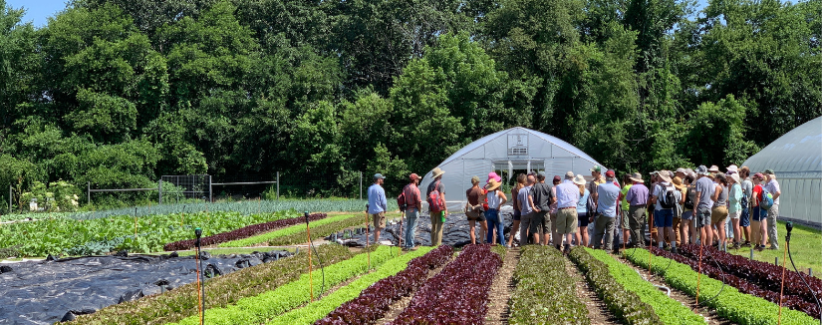Increasing Production by Reducing Tillage: Soil Health Field Day

By Caro Roszell, Photos by Gaining Ground and Frith Farm
On July 14, NOFA/Mass held a Soil Health Field Day in collaboration with Gaining Ground in Concord Mass. It was the first of six on-farm workshops to be held over the next three years as part of a project entitled “Organic No-Till on Northeast Farms: A Practical Exploration of Successful Methods.” This project is funded by a grant from the Natural Resources Conservation Service (NRCS) Conservation Innovation Grant Project. Led by NOFA/Mass in partnership with CT NOFA and NOFA-NJ, the project involves 9 farmer-innovators in three states who are working assiduously to trial and establish effective, scale-appropriate tillage reduction methods on their certified organic farms. (For more information about the project and the other farmers involved, check out the Project Webpage).
Doug Wolcik, farm manager at Gaining Ground (GG) for the past seven years, has made it his mission to increase both the volume and quality of food produced (all of which is donated to food pantries) at GG, especially the volume of food per square foot of land farmed.
He has been able to achieve his mission with the help of a variety of methods that reduce tillage, winnowing soil-disturbing practices down to just two practices: the use of a tilther (a drill-powered shallow wheel-hoe style tool that loosens the top inch of soil) and a BCS-mounted power harrow, which has blades that rotate egg-beater style in the top inch of soil. The rest of the weed management and bed prep is achieved using silage tarps and hand tools, and the outcome is reduced weeds and greater soil health, according to Doug.
The day of the Field Day was bright and hot, but nevertheless 60 people attended to learn about tillage reduction. Doug explained his practices in detail, including bed prep, fertilization, cover crop termination, plant spacing, succession and rotation. Daniel Mays of Frith Farm in Scarborough, ME (a commercial farm of similar scale and practices) walked the farm with Doug and the two farmers discussed variations in the practices between the two farms. Gaining Ground has evolved its practices to integrate 2,500 volunteers each year who help grow 100,000 pounds of freshly-harvested produce donated to hunger relief organizations in metro Boston, while Frith Farm’s approaches are more oriented toward a small, trained farm crew.
Nevertheless, the two farmers shared much in terms of practices and philosophy, and discussion centered on fine details– for instance, variations and possible improvements on the design and use of the simple rope-and-board cover crop crimper that both farms use to flatten cover crops before tarping.
After the farm tour, we retreated for the shade of the barn where Daniel gave a powerpoint presentation of his soil care practices, including no-till, mulching, leaving crop residues in place, multi-cropping and intercropping, cover cropping (including undersowing cover crops into standing crops), livestock integration, and the use of perennial hedgerows. As Daniel’s soil health has improved over the near-decade he has been farming, his farm revenue per square foot has doubled from about 60 cents to approximately $1.80.
Both farmers discussed the importance of increasing food production per square foot not only for donation and revenue benefits, but for the sake of actually taking beds and/or border space out of annual production so that it becomes possible to integrate perennial hedgerows throughout the farm. The hedgerows produce not only culinary and medicinal herbs, fruit, and flowers but also provide benefits such as micro-climate benefits, wind protection, beneficial insect habitat, year-round living roots in the soil and other biodiversity benefits to the whole farm and its annual crops.
After a lunchtime roundtable discussion, attendees dispersed to form small group discussions or to drop in on two different demonstrations taking place at the same time for the final hour of the day: DIY Soil Health Assessment and Soil Microscopy. Participants were invited to bring samples of their soil and look at it under a microscope.
Did you miss this event? Don’t worry! We have two Soil Health on-farm events in September: Farming for Maximum Photosynthesis on September 1st with Julie Rawson at Many Hands Organic Farm and a Soil Health Field Day at Red Shirt Farm on September 30th in Lanesboro, MA with Jim Schultz and Bryan O’Hara (of Tobacco Road Farm in New Lebanon CT).
Farming for Maximum Photosynthesis will focus on no-till vegetable and fruit production using intersown cover crops, heavy mulch, and targeted foliar nutrition, as well as highly integrated animal husbandry (pigs, chickens, and turkeys). Julie will also discuss the variety of related enterprises that are stacked onto and built into this mature bio-diverse agroecological landscape that has been cultivated since the early 80s. (Register now for this event) Red Shirt Farm’s Soil Health Field Day will feature a farm tour including a climate-battery greenhouse, a Johnson-Su bioreactor, and a demonstration of a suite of BCS-mounted no-till equipment including a roller crimper and mini-baler. (Check back at www.nofamass.org/events for registration details which will be posted soon!)
For more information on the farm practices at Gaining Ground, check out our Interview with Doug Wolcik on the NOFA/Mass Podcast. See Season 2, Episode 3: All About Community. Also, you can sign up to volunteer at Gaining Ground and check out the great stories on their Blog!